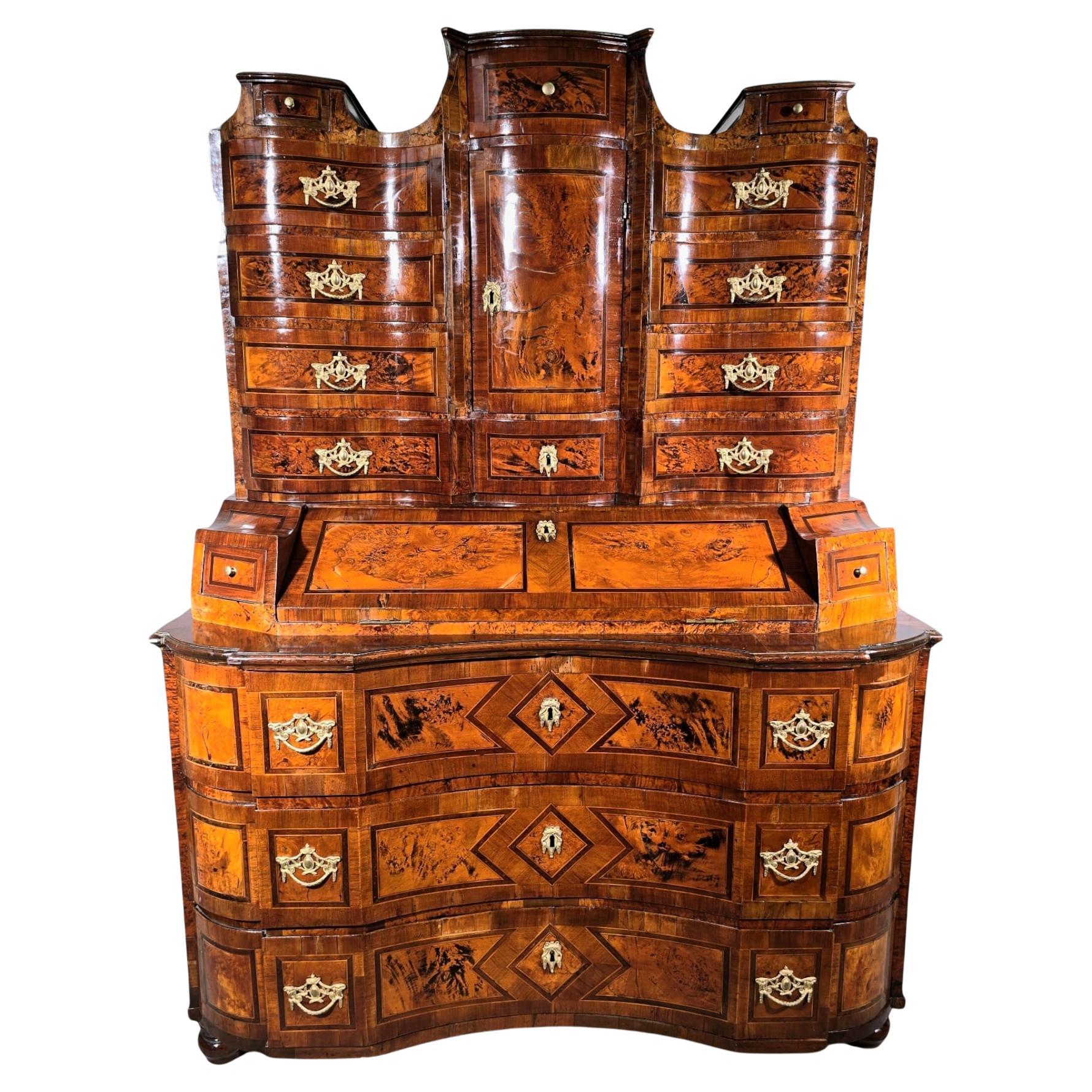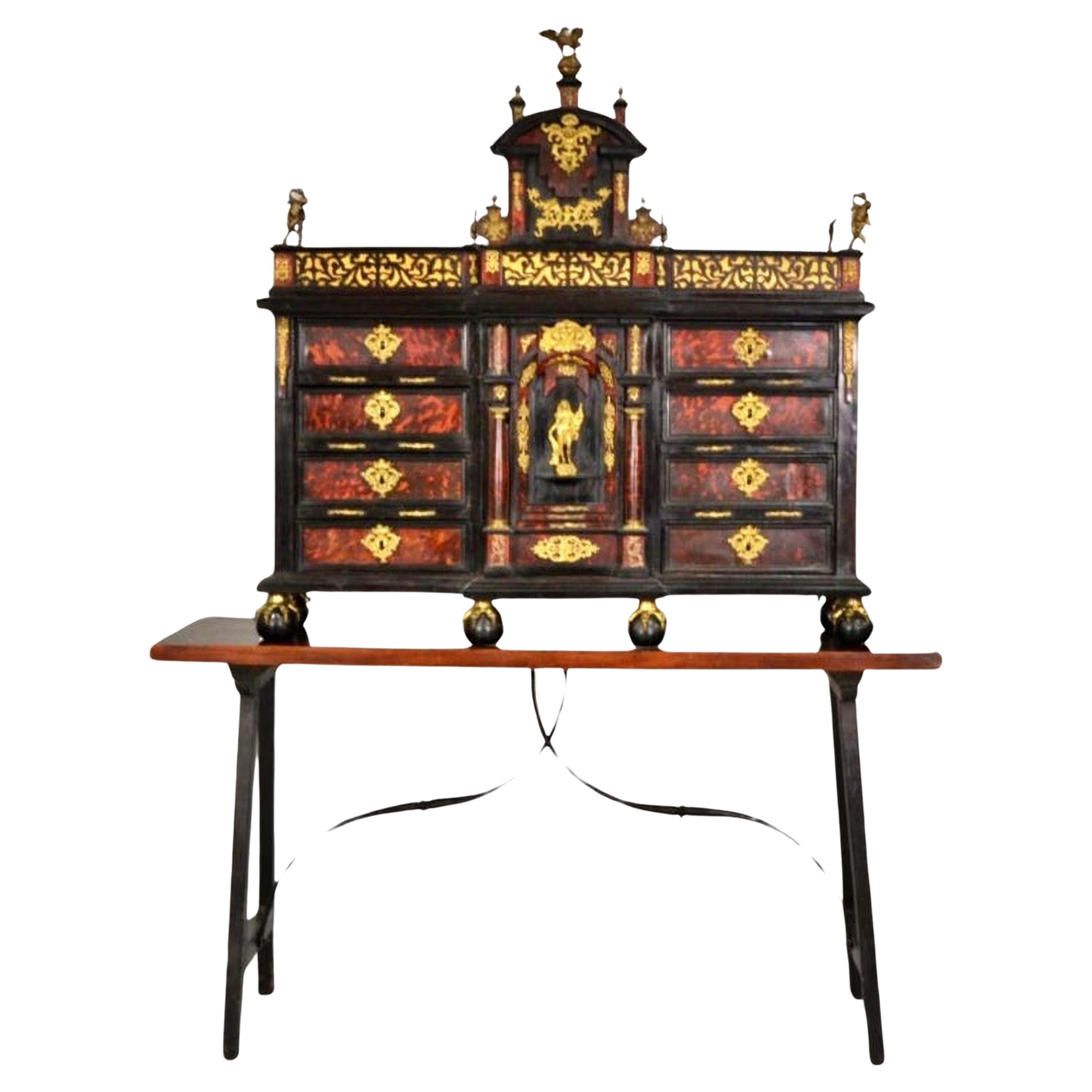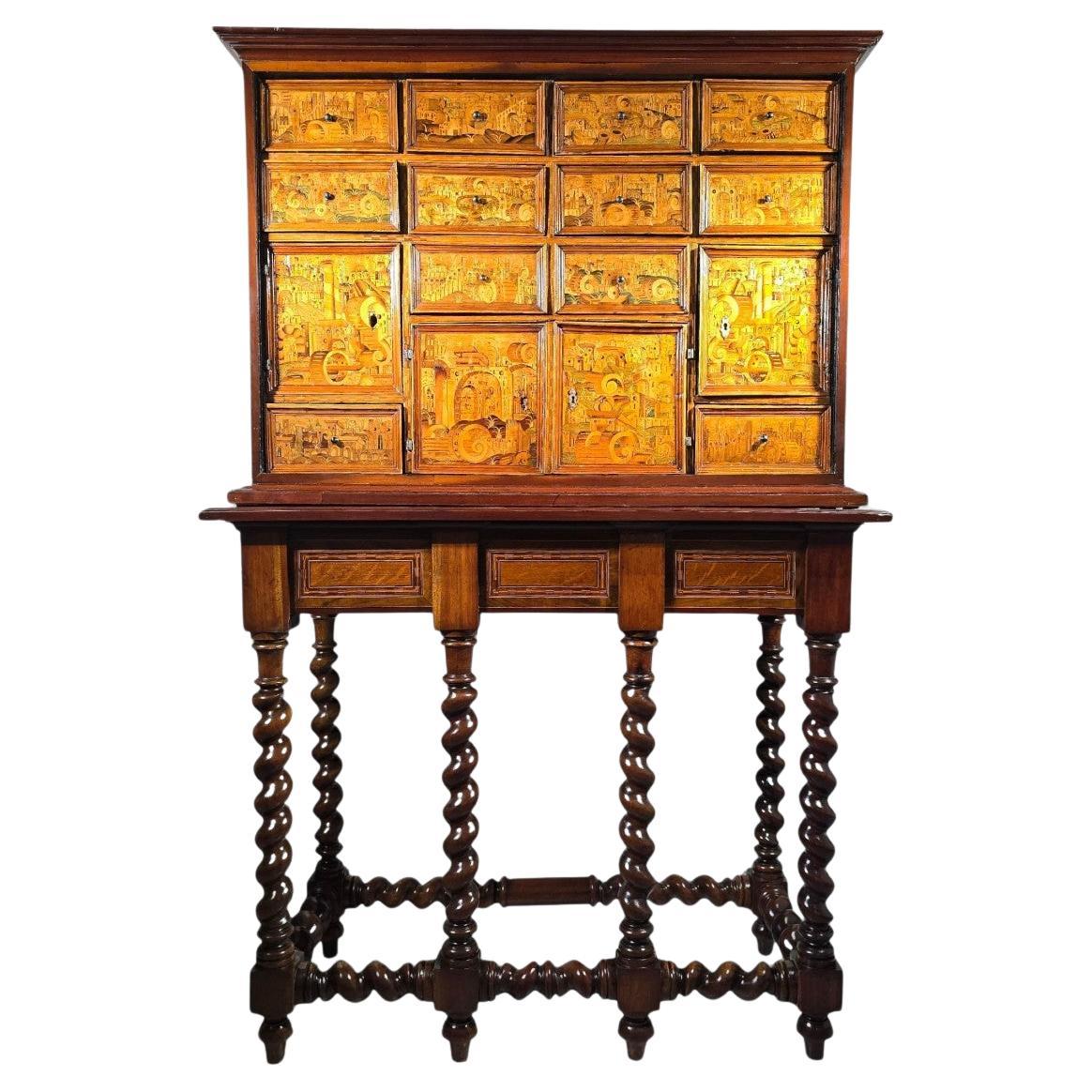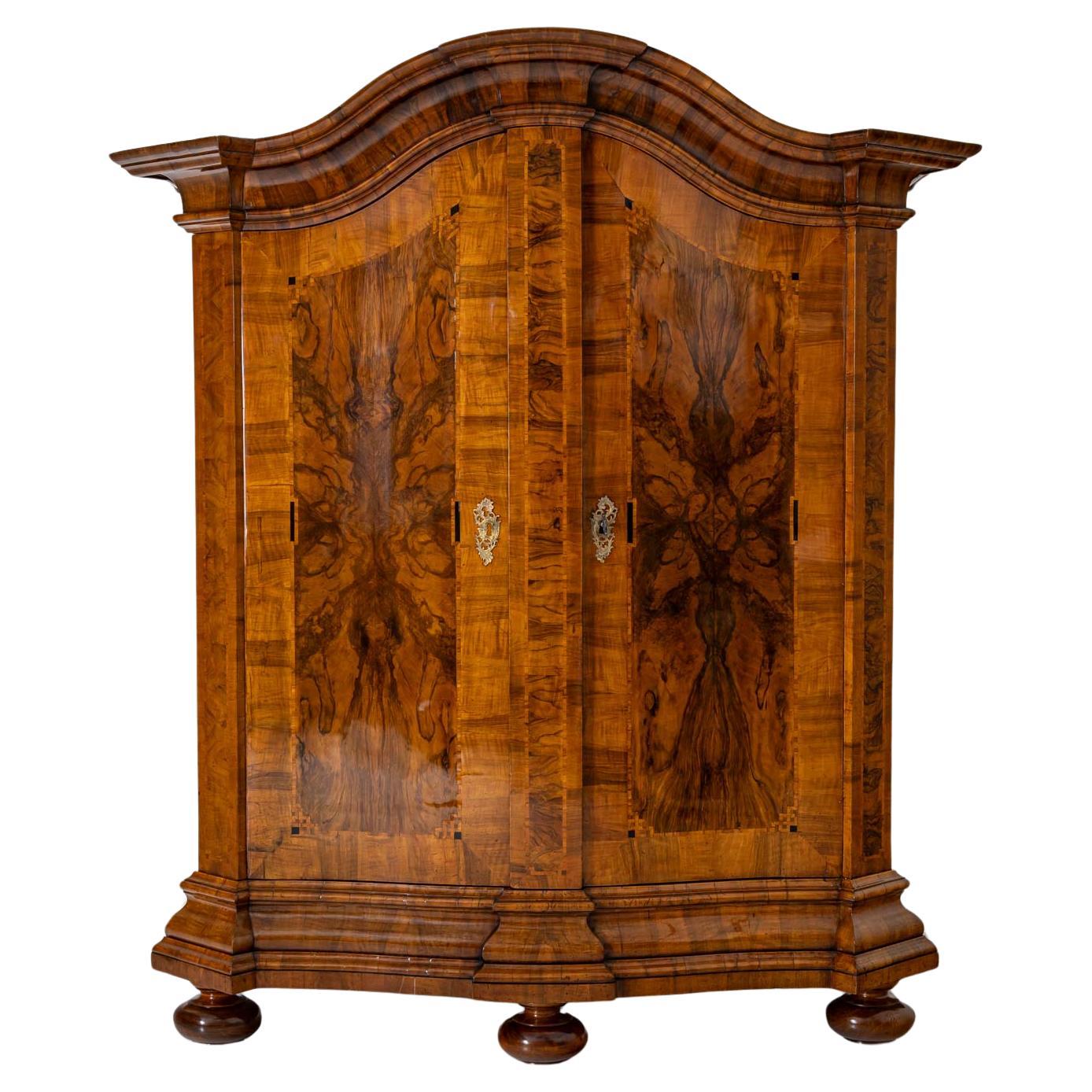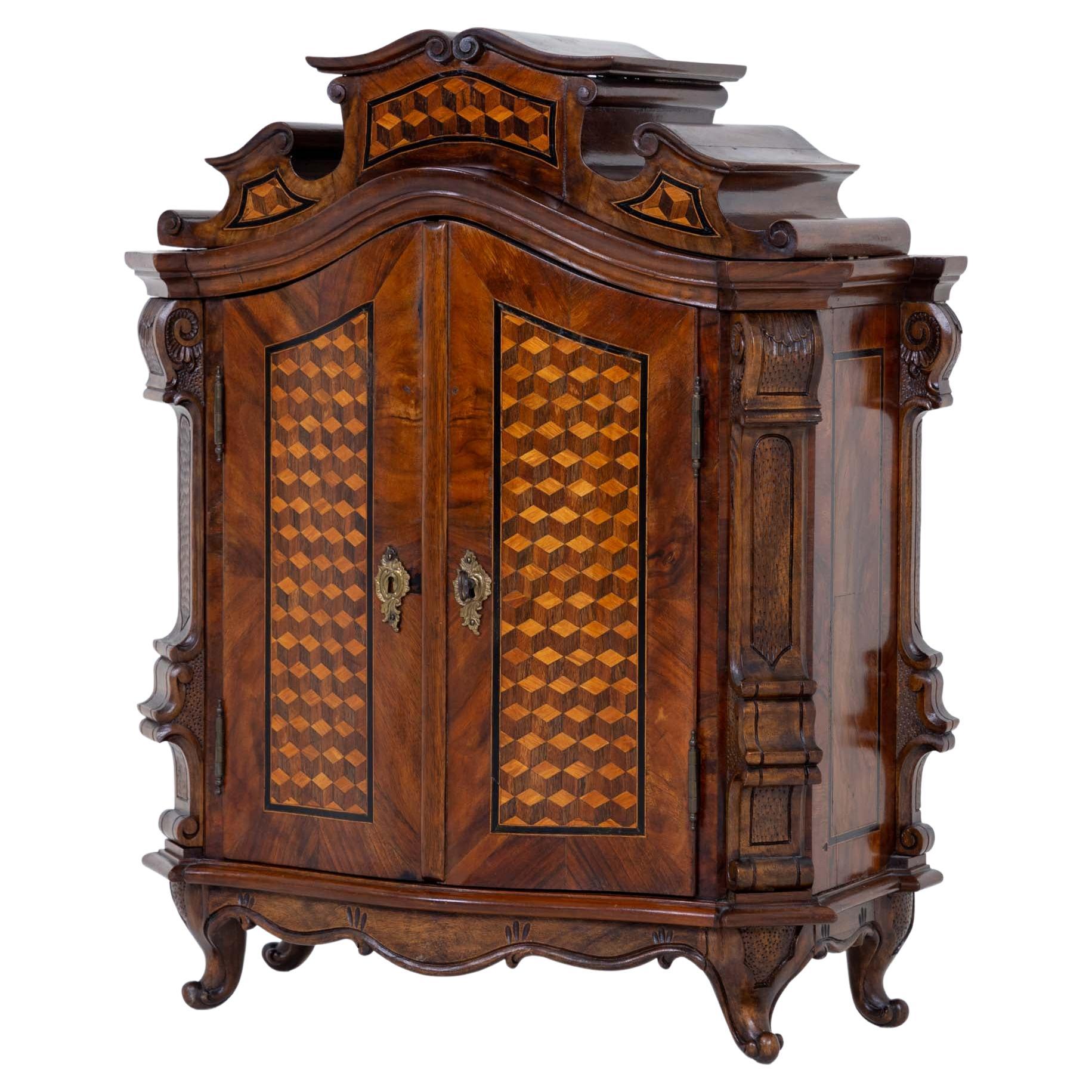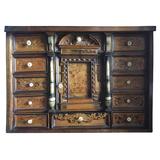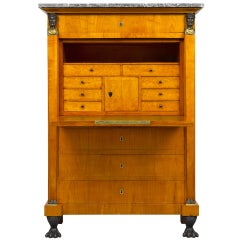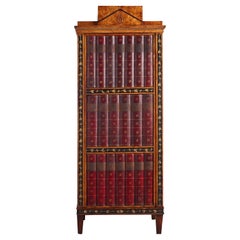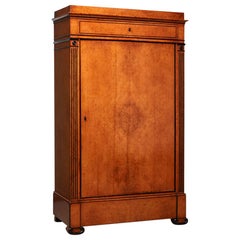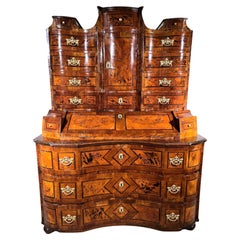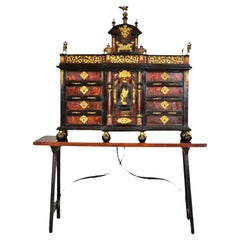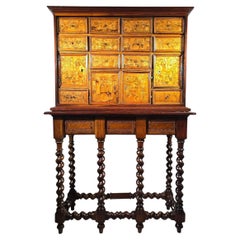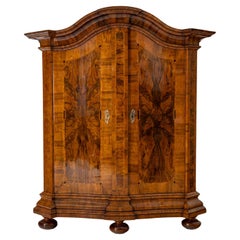Items Similar to Rare 17th Century Baroque Cabinet, South Germany Probably Augsburg, Wunderkammer
Want more images or videos?
Request additional images or videos from the seller
1 of 10
Rare 17th Century Baroque Cabinet, South Germany Probably Augsburg, Wunderkammer
$17,774.60
£13,090.95
€14,800
CA$24,180.95
A$26,870.37
CHF 14,080.36
MX$329,517.21
NOK 179,586.79
SEK 168,948.66
DKK 112,670.13
Shipping
Retrieving quote...The 1stDibs Promise:
Authenticity Guarantee,
Money-Back Guarantee,
24-Hour Cancellation
About the Item
A small architectural table cabinet, veneered in walnut and mulberry, the centre doors enclosing an arrangement of nine various sized drawers with bone knobs, behind a central door a compartment and further three drawers. The cabinet is set with a superstructure above a large frieze drawer, with two finely carved polychrome decorated and parcel gilt winged cherub heads flanking another small pair of doors enclosing further six drawers. A beautiful piece with a fantastic patina will turn every room into a collectors cabinet or Wunderkammer.
Historical note:
Cabinets were the most prestigious pieces of storage furniture during the 16th and 17th century. Such cabinets were a specialty of the south German city of Augsburg and widely exported. Because these cabinets were made from precious materials, such as rare veneers and ivory, and assembled with such skill, they were regarded as fit for princes and noblemen and often served as diplomatic gifts. Sometimes they were supplied already fitted with a variety of small, rare, collectable objects. Some were from the natural world, such as coral or shells, and others were ’artificial’ or examples of human skill, such as watches or pieces of fine ivory turning.
- Dimensions:Height: 33.86 in (86 cm)Width: 20.87 in (53 cm)Depth: 9.45 in (24 cm)
- Style:Baroque (Of the Period)
- Materials and Techniques:
- Place of Origin:
- Period:Late 17th Century
- Date of Manufacture:circa 1660-1680
- Condition:Wear consistent with age and use.
- Seller Location:Worpswede / Bremen, DE
- Reference Number:Seller: 18821stDibs: LU981418942752
About the Seller
5.0
Recognized Seller
These prestigious sellers are industry leaders and represent the highest echelon for item quality and design.
Established in 1979
1stDibs seller since 2013
27 sales on 1stDibs
Typical response time: 1 to 2 days
- ShippingRetrieving quote...Shipping from: Worpswede / Bremen, Germany
- Return Policy
Authenticity Guarantee
In the unlikely event there’s an issue with an item’s authenticity, contact us within 1 year for a full refund. DetailsMoney-Back Guarantee
If your item is not as described, is damaged in transit, or does not arrive, contact us within 7 days for a full refund. Details24-Hour Cancellation
You have a 24-hour grace period in which to reconsider your purchase, with no questions asked.Vetted Professional Sellers
Our world-class sellers must adhere to strict standards for service and quality, maintaining the integrity of our listings.Price-Match Guarantee
If you find that a seller listed the same item for a lower price elsewhere, we’ll match it.Trusted Global Delivery
Our best-in-class carrier network provides specialized shipping options worldwide, including custom delivery.More From This Seller
View AllEarly 19th Century Dutch Floral Marquetry Bureau Display Cabinet
Located in Worpswede / Bremen, DE
The moulded cornice above two shaped glass panelled doors opening to shelves, the lower part with a hinged sloping fall front opening to reveal a fitted interior with a central door ...
Category
Antique 19th Century Dutch Neoclassical Secretaires
Materials
Ormolu
$7,806 Sale Price
51% Off
Swiss Early 19th Century Empire Bureau Cabinet, Signed Hirschgartner
Located in Worpswede / Bremen, DE
This fine Empire drop-front secretary (secrétaire a'abattant or secrétaire en armoire) with a writing and standing desk is signed M. Hirschgartner. Hans Martin Hirschgartner (1766-18...
Category
Antique 19th Century Swiss Empire Secretaires
Materials
Marble
Unusual German Neoclassical Cabinet with Faux-Book Spine Decorated Door
Located in Worpswede / Bremen, DE
An unusual and decorative cabinet of architectural form with one faux-book spine decorated door, enclosing two shelves. The stepped pediment with one drawer veneered with burl wood a...
Category
Antique Early 19th Century German Neoclassical Cabinets
Materials
Metal
Architectural Early 19th Century German Biedermeier Cabinet
Located in Worpswede / Bremen, DE
A very rare and elegant Biedermeier cabinet of architectural form. Very simple in design with a fantastic and warm burr-ash veneer, accentuated with ebonized thread inlay, discs and ...
Category
Antique Early 19th Century German Biedermeier Cabinets
Materials
Ash, Fruitwood
Important Early 19th Century Danish Neoclassical Secretaire NIcolai Abildgaard
By Nicolai Abildgaard
Located in Worpswede / Bremen, DE
The slender secretaire on an unusual high stand with four curved legs dived into quarters, the frame with a central inlaid palmette motif. The fall down writing flap, enclosing a fitted interior with numerous drawers, above and below are two doors enclosing one shelf. The top of the secretaire in form of a classical triangular pediment, the center of which is decorated with an inlaid stylized anthemion. The entire front is very plain and geometrical, divided into six panels inlaid with rectangular fields in light wood.
The design of this mahogany secretaire is based on classical Roman and Greek models, in this case the bookcases that were portrayed on frescoes, reliefs and Roman gold glass. As secretaires were not known in Antiquity, Abildgaard designed his secretaire as a cupboard though in such a way, that the two centre doors are actually a fall front writing top. The carved turned underframe is inspired by Etruscan footstools, which were known especially from reliefs and had been reproduced in contemporary prints. Abildgaard designed this piece of furniture far more in accordance with ancient tradition than did the other furniture designer of the day. The most important (and avantgarde) piece of the furniture Abildgaard designed in the first decade of the 19th century, is this secretaire, which marks a real renewal in relation to the secretaires that constituted the master's test for the members of the guild of cabinetmakers at this time. Compared with these, this secretaire is a very light piece of furniture that does not follow the contemporary fashion towards classical architectural decorations such as columns, pillars, architraves, etc. which often endow such pieces.
Nicolai Abraham Abildgaard (11 September 1743 – 4 June 1809) was a leading Danish Neoclassical painter who also designed (mostly for his own use) elegant Grecian furniture...
Category
Antique Early 19th Century Danish Neoclassical Secretaires
Materials
Bone, Maple
Danish 18th Century Rococo Walnut Commode Mathias Ortmann
By Mathias Ortmann
Located in Worpswede / Bremen, DE
A very charming and small Danish parcel-gilt walnut and burr-walnut commode by Mathias Ortmann, mid-18th century. The shaped veneered top above moulded frieze with punched ground inc...
Category
Antique Mid-18th Century Danish Rococo Commodes and Chests of Drawers
Materials
Bronze
You May Also Like
18th Century German Baroque Cabinet
Located in Madrid, ES
An elegant German cabinet from the early 18th century, circa 1720, crafted from a combination of fine woods including walnut, olive, ebony, and cherry. This piece exemplifies the cra...
Category
Antique 1720s Cabinets
Materials
Fruitwood
Important Spanish Cabinet, 17th Century
Located in Madrid, ES
Important Spanish Cabinet 17th century
in blackened wood and tortoiseshell veneer.
It opens with eight drawers framing a central door, surrounded by two columns.
Richly decorated w...
Category
Antique 17th Century Spanish Baroque Cabinets
Materials
Bronze
Important German cabinet from Augsburg – End of the 16th / Beginning of the 17th
Located in Madrid, ES
Magnificent and rare German cabinet from Augsburg, dating from the late 16th to early 17th century. Crafted from light fruitwoods, this exceptional piece is richly decorated with fin...
Category
Antique 16th Century German Baroque Cabinets
Materials
Wood
Baroque cabinet, Franconia, Germany, 2nd half 18th Century
Located in Greding, DE
Large two-door Baroque cabinet with bevelled corners and a profiled and curved cornice. The cabinet stands on pressed ball feet and is veneered in walnut. The interior is divided int...
Category
Antique 18th Century German Baroque Cabinets
Materials
Walnut
Miniature Baroque Cabinet, Southern Germany, Mid-18th Century
Located in Greding, DE
Small baroque cabinet with multiple curved top and frame and volute decorations on the corners. The two-door body is veneered in walnut and shows...
Category
Antique Mid-18th Century Baroque Cabinets
Materials
Wood
Augsburg Cabinet, 17th Century, Germany
Located in Schellebelle, BE
Exceptional Augsburg cabinet, Germany, 17th century
with precise marquetry of birds and animals
diiferent kind of woods.
Category
Antique 17th Century German Cabinets
Materials
Wood
More Ways To Browse
Ivory German
17th Century German
German Baroque Furniture
16th Century German
Walnut Cabinet German
17th Century Carved Cabinet
German Kitchen Cabinets
Carved Shell Cabinet
Cherub Heads
Baroque Kitchen Cabinet
German Carved Cabinet
Watch Cabinet
Polychrome Cabinet
Cherub Cabinet
Antique Cherub Cabinet
16th Century Brass
Antique Ivory Cabinets
German Carved Walnut Antique Furniture
